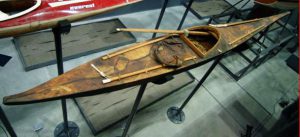 Hunting kayaks have been used in the Arctic for thousands of years, making it possible for the Inuit people to survive in these remote and hostile regions.
Hunting kayaks have been used in the Arctic for thousands of years, making it possible for the Inuit people to survive in these remote and hostile regions.
At sea the kayak was used to hunt seals, walruses and whales, relying on stealth for a close approach.
The boats were built from materials that were readily available. The rigid framework is generally of driftwood and pegged or lashed together with sinew or sealskin cord. Seal skins are stretched tightly over the framework and lashed together with more sinews. The result is an extremely strong and waterproof craft, capable of being paddled at speed in sometimes rough conditions. The hunting equipment is carried on deck, secured under leather straps with fittings of ivory or antler.
A kayak is tailor-made to fit its owner so that he can be in complete control of his boat in all kinds of weather. The total length of the kayak is approximately three times the height of its user. Width is dependent on the kayaker’s shape, particularly at the hips.
There is a wide variety of designs, depending on the local conditions and the animals being hunted, but the long, narrow shape and skin-on-frame construction is found from Siberia to the east coast of Greenland.
Great skill is required to avoid becoming entangled and capsized during the hunt, and the ability to roll the kayak was very valuable. Within the last century the arctic kayak form has been adopted, copied and modified by boat builders. Initially they were built in wood and canvas, then plywood, and most recently glassfibre and plastic. Modern sea kayaks are direct descendants of those used by the Inuit people.
The Museum kayak, from the Frobisher Bay area, was presented to Queen Elizabeth II by the Frobisher Bay community in 1970 and is on permanent loan.

